
Dimdima
Online Children's Magazine from India

Dimdima
Online Children's Magazine from India
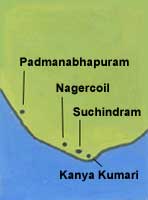
Leaving the enchanting coral islands of Lakshadweep, we return to the mainland, to the coastal town of Padmanabhapuram which is about 55 km south of Thiruvananthapuram.
Although Padmanabhapuram is now a part of Tamil Nadu, it used to be the ancient capital of the Travancore maharajas from the 16th to the 18th centuries.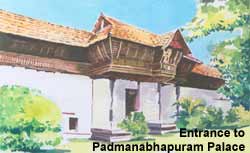
The Padmanabhapuram palace, where the maharajas of Travancore lived till the early half of this century is situated at the centre of the Padmanabhapuram fort. It is regarded as one of the finest specimens of wooden architecture on the west coast.
The walls of the palace were built at an angle to block out solar glare and heat. The floors that shine like polished mirrors are made from a unique blend of coconut shells and egg white. The cot in the king's bedroom is made of 63
varieties of medicinal wood, believed to have been presented by Portuguese visitors. The queen's bed is inlaid with ivory.
A huge stone ball that lies loosely atop a stone pillar of the palace was used in the olden days to test the strength of persons seeking recruitment into the army. Only those who could lift the stone ball were selected.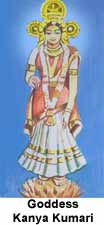
Sixteen kilometres south of Padmanabhapuram is the Suchindram temple, famous for the thirty shrines within it. Lord Indra is said to have dipped his hand in boiling ghee to atone for his sins, here at Suchindram. Until a few decades ago a person suspected of a crime had to go through the 'boiling ghee' ordeal in the temple grounds. The person had to undergo a fast and then plunge his hand into a vessel containing boiling ghee. If there were no blisters on his hand three days later, he was declared innocent.
The hollow trunk of a 2,500-year-old tree faces the 41 m high 'gopuram', The hollow contains images of the holy trinity - Brahma, Vishnu and Maheshwara - in the form of lingams.
A gigantic statue of Hanuman stands within the temple precincts. Ganges water mixed with rose water is poured over the statue's head and the water collected at the feet is given as 'tirtha' to devotees.
In the temple's northern corridor are four musical pillars hewed out of a single block of granite. The pillars consist of cylindrical rods which when tapped, produce musical notes. Some rods produce the sound of the Jalataranga, some, that of the tambura, others, the mridangam (drum) and still others, the veena.
At the southernmost tip of the country, where the waters of the Arabian Sea, the Bay of bengal and the Indian Ocean mingle, stands the celebrated temple of Kanya Kumari, the Virgin Goddess.
Legend has it that the deity at the Suchindram temple fell in love with the beautiful goddess and told the devas of his intention to marry her. The devas, fearing that the goddess would lose her powers if she got married, sought Narada's help to prevent the marriage.
Narada told the bridegroom that the auspicious hour for the marriage was just before dawn. He then turned himself into a cock and crowed loudly before the marriage party coUld reach its destination. The bridegroom thinking that dawn had broken, returned sadly to Suchindram.
The goddess was furious when the god did not show up and threw the food prepared for the feast outside where it got miraculously transformed into sea-shells and sands of myriad hues.
The sands at Kanya Kumari are red, brown, yellow, silver, orange, dark blue and purple. They contain monozite. Uranium, valuable for generating atomic energy, is extracted from these sands. One of the famous landmarks of Kanya Kumari is the 'Gandhi Mandapam' built at the spot where Mahatma Gandhi's ashes were once kept.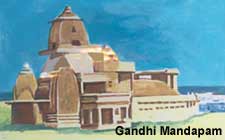
The mandapam consists of a simple chamber. A black marble slab indicates the exact spot where Gandhiji's ashes were placed before immersion.
Directly above this slab on the ceiling is a small hole. Every year on October 2 on Gandhi's birthday, sunlight enters through this minute hole and casts a long beam on the slab.
Hundreds of people gather on this day to watch this moving sight.
Half a kilometre into the sea stands a rock where the Goddess Kanya Kumari is said to have prayed to Lord Shiva. It is also the place where the great philosopher and social reformer, Swami Vivekananda, meditated three days and nights in December 1892.
In 1970, the Vivekananda Kendra inaugurated the Vivekananda Rock Memorial at this spot.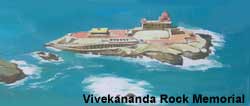
Adjacent to the Vivekananda Rock Memorial stands another rock, where a 3 m tall statue of the poet-saint Tiruvalluvar is in the process of being erected.
Tiruvalluvar is regarded as the author of 'Tirukkural', the 'Tamil Veda'.
Not far from Kanya Kumari is Maruda Malai, a hill where medicinal herbs grow in abundance. These herbs are used in the preparation of Ayurvedic medicines.
The story goes that when Lakshmana was hit by a poisonous arrow while fighting Ravana, Rama asked Hanuman to fetch the medicinal herb, Sanjivini, from a mountain in the Himalayas. The Sanjivini was an antidote to all poisons.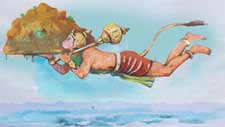
Unable to locate the Sanjivini, Hanuman uprooted the entire mountain and as he was carrying it to Lanka, a small piece of the mountain fell down and formed the Maruda Malai. There is a lingam here that is believed to have been installed by Hanuman.
Last updated on :5/14/2005
Dimdima is the Sanskrit word for ‘drumbeat’. In olden days, victory in battle was heralded by the beat of drums or any important news to be conveyed to the people used to be accompanied with drumbeats.
Bharatiya Vidya Bhavan
K. M Munshi Marg,
Chowpatty, Mumbai - 400 007
email : editor@dimdima.com
Bharatiya Vidya Bhavan
505, Sane Guruji Marg,
Tardeo, Mumbai - 400 034
email : promo@dimdima.com
Dimdima.com, the Children's Website of Bharatiya Vidya Bhavan launched in 2000 and came out with a Printed version of Dimdima Magazine in 2004. At present the Printed Version have more than 35,000 subscribers from India and Abroad.